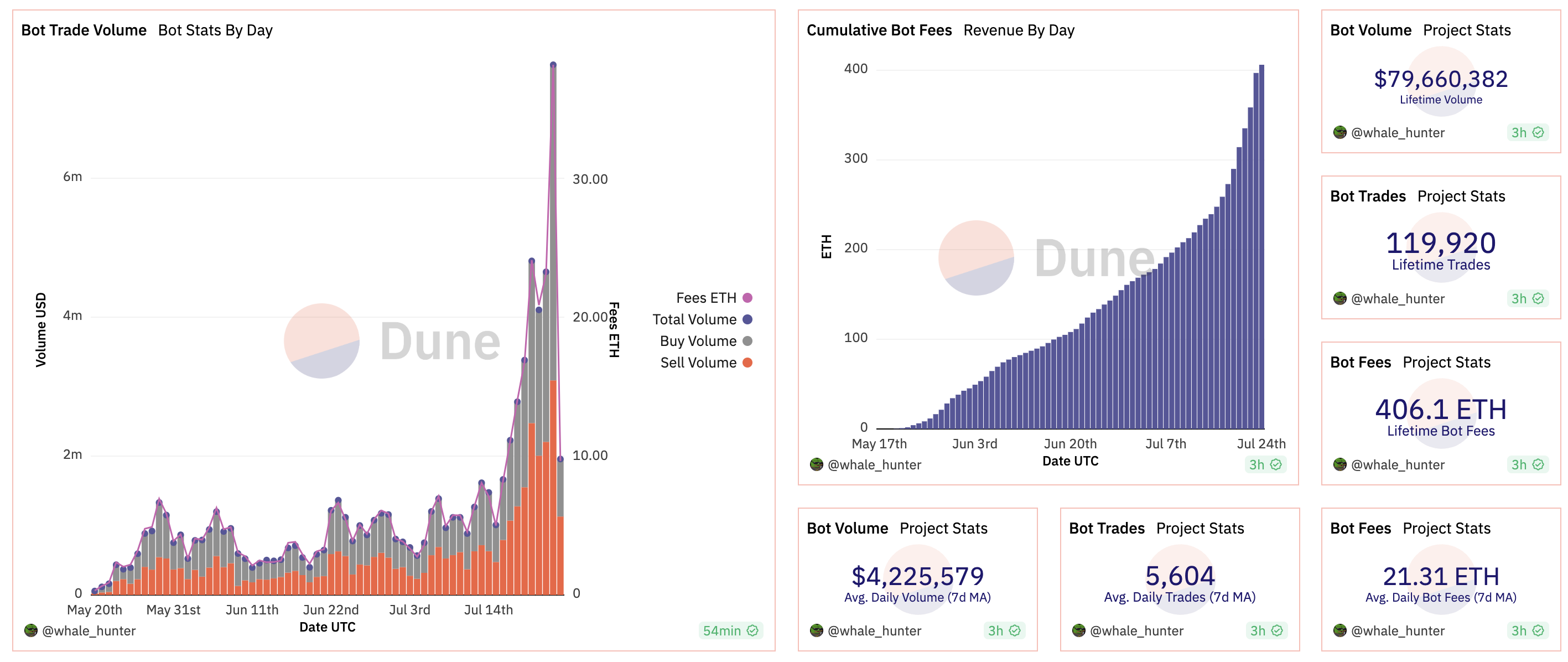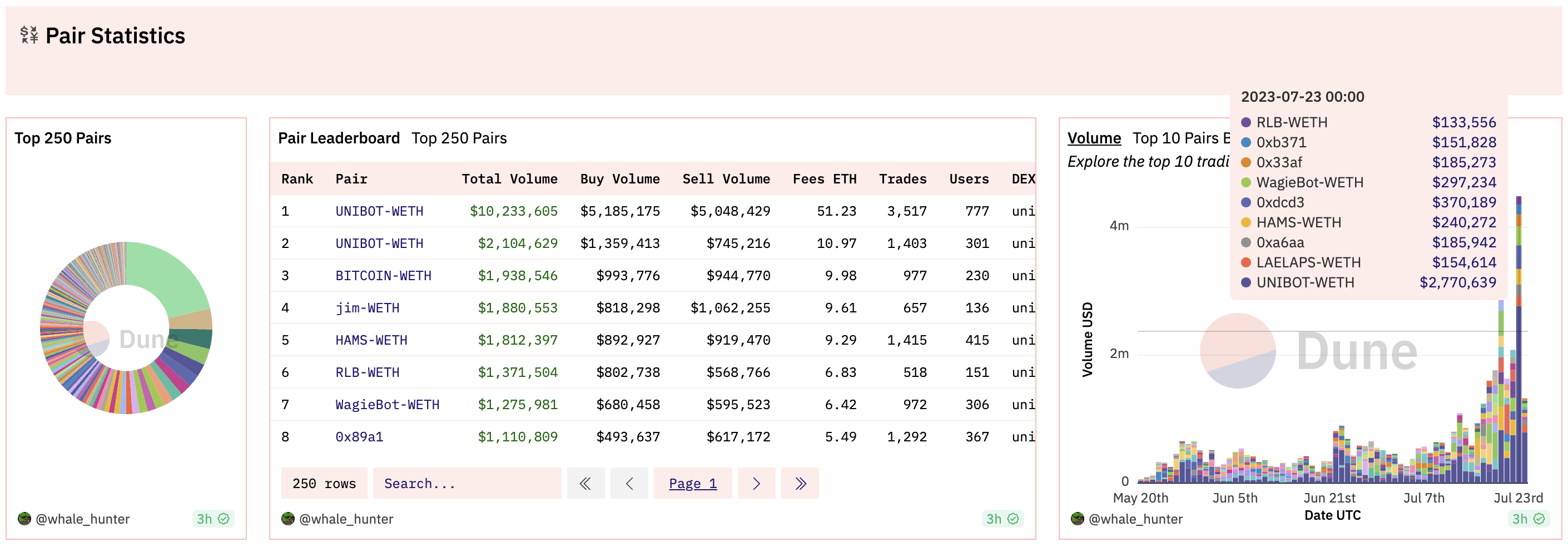Author: Jiang Haibo, LianGuaiNews
Telegram trading bots have been around for a while. Recently, with the popularity of MEME tokens and the launch of projects like Unibot, this field has once again attracted attention.
According to data from DeFiLlama, as of July 24th, among all blockchain projects, Unibot’s fees generated in the past 24 hours are only surpassed by Ethereum, Lido, Bitcoin, Uniswap, and Tron. After excluding public chain projects, it is only surpassed by Lido and Uniswap. Since Lido requires users to stake ETH to generate income, 90% of the fees are distributed to users who stake ETH, and the protocol’s income is only 10% of the fees generated. Uniswap’s fees are all allocated to liquidity providers, and the protocol has no income. As a service provider, Unibot’s income is 100% relative to the fees generated. Its income of $665,000 in the past 24 hours ranks first among non-public chain projects. Based on this, Unibot will distribute part of the income to holders of its native token, while Lido and Uniswap currently have no plans to distribute profits to token holders.

- LianGuai Observation | Entering the Global Financial System Musk X Takes Half, Worldcoin Takes All’ Note The translation may vary depending on the context.
- Worldcoin’s Open Letter on Coin Issuance A New Identity and Financial Network for 8 Billion People Worldwide, Now Open!
- CZ reissues an article from 6 years ago A journey of a thousand miles begins with a single step, entrepreneurship starts from doing small things.
Unibot’s Services and Fee Mechanism
Unibot’s Telegram bot completes transactions through conversations with users. The entire process can be summarized as follows:
- Click “Start Trading” on Unibot’s official website to initiate a transaction and open the Unibot conversation box on Telegram;
- Unibot generates three addresses for each Telegram user;
- Users can deposit funds to Unibot’s addresses using wallets such as MetaMask;
- Select “Buy Tokens” from the options provided in the conversation box;
- Select the wallet for the transaction and the amount to be purchased;
- Enter the address of the token to be purchased to complete the transaction.
Compared to decentralized wallets like MetaMask, Unibot’s user experience is more similar to centralized products. However, security should also be taken into account during this process. The generated addresses can be replaced by refreshing, but the private keys need to be saved before doing so. Exporting and storing private keys should also be done to avoid leakage. It is important to verify the input address to prevent purchasing counterfeit tokens. Unibot generates fees through two methods: transaction fees from the Unibot Telegram bot and transaction taxes from the native token $UNIBOT.
- Unibot charges a fee of 1% of the trading volume on the Unibot Telegram bot. 40% of this fee is distributed to holders of the $UNIBOT token, while the remaining fees are allocated to the team and used for referral rewards. Users can refer others to use the Unibot bot for trading and receive 25% of the referred user’s trading fees.
- The $UNIBOT token has a 5% tax on transactions, with 1% of the trading volume distributed to $UNIBOT token holders. During the first 90 days, this distribution ratio is doubled.
- If more than 200 $UNIBOT tokens are sold or transferred in each reward cycle, the rewards will be confiscated and returned to the reward pool.
This means that currently, about 40% of the fees generated by Unibot are distributed to holders of the $UNIBOT token.
According to the Dune dashboard provided by the Unibot official website, the fees generated by Unibot on July 23rd were 337.54 ETH, which, based on Binance’s closing price of $1888.73, is equivalent to about $637,500. Since Unibot is a service provider and does not need to allocate fees to liquidity providers like Uniswap and other DeFi projects, if it continues to generate income of $637,500 per day and 40% of it is distributed to $UNIBOT holders, based on the static data of a $140 million market value for $UNIBOT, its P/E ratio is only 1.5. If Unibot’s data can be sustained, the $UNIBOT token will be highly competitive.
Robot Trading Fees and Percentage of $UNIBOT Trading Taxes
According to data from Dune, as of July 23rd, all fees in Unibot have reached new highs. The total fee on July 23rd, 337.54 ETH, is 2.35 times that of July 22nd’s 143.55 ETH, which directly boosted the price of $UNIBOT to $140 on July 24th.

Using the data from July 23rd as an example, the fees generated by robot trading are 38.42 ETH, and about 300 ETH in fees are generated by $UNIBOT’s trading taxes, accounting for approximately 89% of the trading taxes.
Before this, many MEME tokens also had trading taxes set up to be distributed to the team, token holders, burned, or added to liquidity. However, the incentive effects of such tokens often cannot be sustained.
Robot Trading Fees
The trading fees generated by Unibot robots belong to “real income,” but as mentioned above, this accounts for only about 11% of the total fees. The total trading volume generated by Unibot robots in the past was $79.66 million, with about 120,000 transactions, accumulating a total of 396.92 ETH in fees.

According to data from Dune, robot trading fees are also on the rise, with fees on July 23rd being 1.65 times that of the previous day, but the growth rate is not as fast as $UNIBOT’s tax revenue.
Source of Unibot’s Trading Volume
Using the data from July 23rd as an example again, among the top ten trading pairs in Unibot’s trading volume, the UNIBOT-WETH trading pair has an absolute advantage, being 7.5 times the trading volume of the second place.

In the past three days of trading, excluding UNIBOT-WETH, 53.6% of the trading volume comes from the HAMS-WETH trading pair. $HAMS is the token of the real version of the online hamster racing game Hamsters.gg.

In all of Unibot’s trades, tokens with high trading volumes include popular tokens and MEME tokens on Ethereum, such as $BITCOIN, $jim, $RLB, etc. However, whether the hot trends of such tokens can be sustained is questionable.
Summary
The current static data of $UNIBOT is very attractive, with a P/E ratio of only 1.5. However, about 89% of this comes from $UNIBOT’s trading taxes, and only about 11% comes from the real income generated by robot trading. In general, the dividends provided by trading tax projects cannot be sustained in the long run.
In Unibot’s trading volume, there is also a relatively high proportion that comes from UNIBOT itself. In addition, the trading volume of projects such as $BITCOIN, $jim, $HAMS on Ethereum is also relatively high in Unibot. This indicates that Unibot is indeed suitable for the discovery of popular projects, but whether the hot trends of the traded projects can be sustained is also a question.
Like what you're reading? Subscribe to our top stories.
We will continue to update Gambling Chain; if you have any questions or suggestions, please contact us!